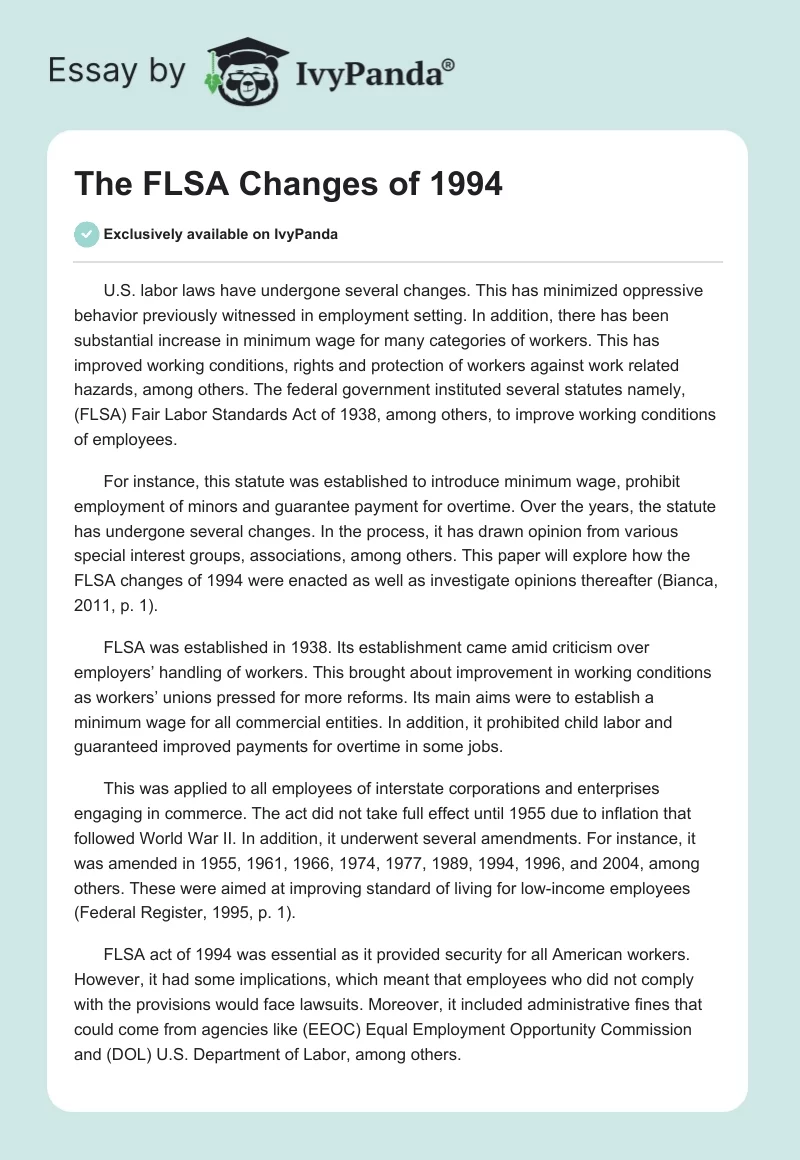U.S. labor laws have undergone several changes. This has minimized oppressive behavior previously witnessed in employment setting. In addition, there has been substantial increase in minimum wage for many categories of workers. This has improved working conditions, rights and protection of workers against work related hazards, among others. The federal government instituted several statutes namely, (FLSA) Fair Labor Standards Act of 1938, among others, to improve working conditions of employees.
For instance, this statute was established to introduce minimum wage, prohibit employment of minors and guarantee payment for overtime. Over the years, the statute has undergone several changes. In the process, it has drawn opinion from various special interest groups, associations, among others. This paper will explore how the FLSA changes of 1994 were enacted as well as investigate opinions thereafter (Bianca, 2011, p. 1).
FLSA was established in 1938. Its establishment came amid criticism over employers’ handling of workers. This brought about improvement in working conditions as workers’ unions pressed for more reforms. Its main aims were to establish a minimum wage for all commercial entities. In addition, it prohibited child labor and guaranteed improved payments for overtime in some jobs.
This was applied to all employees of interstate corporations and enterprises engaging in commerce. The act did not take full effect until 1955 due to inflation that followed World War II. In addition, it underwent several amendments. For instance, it was amended in 1955, 1961, 1966, 1974, 1977, 1989, 1994, 1996, and 2004, among others. These were aimed at improving standard of living for low-income employees (Federal Register, 1995, p. 1).
FLSA act of 1994 was essential as it provided security for all American workers. However, it had some implications, which meant that employees who did not comply with the provisions would face lawsuits. Moreover, it included administrative fines that could come from agencies like (EEOC) Equal Employment Opportunity Commission and (DOL) U.S. Department of Labor, among others.
The act involved issues dealing with compensation of claimant. It clarified on the number of years for recovery of overtime compensation. In light of this, the General accounting office (GAO) ruled that the compensations be backdated for 6 years (U.S. Department of Labor, 2011, p. 1).
Most special interest groups were concerned about compensation dates as well as the administrative fines. They also raised concerns over delayed payments as well as the retroactive period for claimant of overtime. Another cause of disagreement was in child labor. These entailed hours of work and work hazards, among others. For instance, whenever a child encountered an accident at work, the employer would not be held liable.
Instead, it would go towards his/her parent’s health insurance. This was quite astonishing given that the accident was encountered at work. In this regard, special interest groups and human rights associations, among others, called for further reforms. Ultimately, the act underwent a number of reforms, which include further increase in minimum wage to $7.24 per hour. Moreover, other changes such as minimum working hours per day, per week and exemptions were outlaid (Clark, 2006, p. 1).
The FLSA laws have undergone several changes over the decade since its establishment in 1938. One of the main reasons for its established by the federal government was to improve working conditions. This was achieved by introducing minimum wage, laws prohibiting and regulating child labor as well as those guaranteeing payment of overtime.
It is also important to note overtime payments were one-half over the normal rate of payment. However, the changes in 1994 drew criticism from special interest groups among other associations. This resulted in more reforms that transformed the whole sector (Bianca, 2011, p. 1).
References
Bianca, A. (2011). The Fair Labor Standards Act of 1994. eHow. Web.
Clark, M. (2006). DOL continues to clarify FLSA issues: opinion letters shed light on coverage questions. CBS Interactive Business Network. Web.
Federal Register. (1995). Proposed Rule: Pay Administration Under the Fair Labor Standards Act. Federal Register. Web.
U.S. Department of Labor. (2011). Wage and Hour Division (WHD). Department of Labor. Web.


